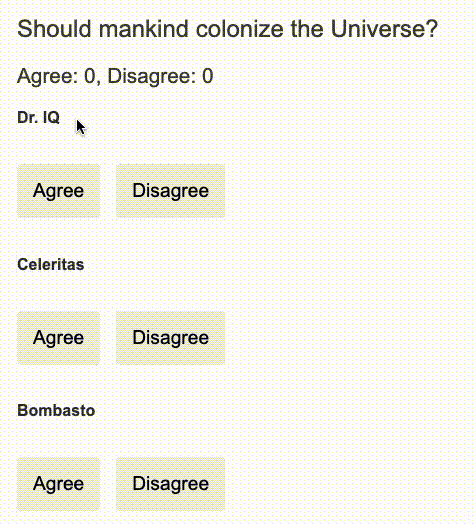親から子に情報を与える場合
親の変化を子で何かするときに使用します。
Inputを使用する
公式
子コンポーネントでは親から取得したデータを格納するプロパティに@Input()デコレーションを定義します。親のテンプレートの[]で指定した値をそのまま使用する場合は、引数なしの@Input() プロパティ名 :型で良いですが、変える場合は@Input('ほにゃらら') プロパティ名 :型にします。
(今回の場合親のテンプレートでは[master]と定義していますが、子ではmasterNameとして使用します。)
import { Component, Input } from '@angular/core';
import { Hero } from './hero';
@Component({
selector: 'hero-child',
template: `
<h3>{{hero.name}} says:</h3>
<p>I, {{hero.name}}, am at your service, {{masterName}}.</p>
`
})
export class HeroChildComponent {
@Input() hero: Hero;
@Input('master') masterName: string;
}
親コンポーネントのテンプレートで値を渡します。
[ほにゃらら]部分に、子のプロパティ名を指定し、右辺に渡すプロパティや、定数を指定します。
(文字列を渡す時は[ほにゃらら]="'hogehoge'"の様に、シングルクォートを忘れない様にしましょう)
import { Component } from '@angular/core';
import { HEROES } from './hero';
@Component({
selector: 'hero-parent',
template: `
<h2>{{master}} controls {{heroes.length}} heroes</h2>
<hero-child *ngFor="let hero of heroes"
[hero]="hero"
[master]="master">
</hero-child>
`
})
export class HeroParentComponent {
heroes = HEROES;
master: string = 'Master';
}
アクセサを使う
公式
アクセサ(get/set)を使うこともできます。プロパティをprivateにしたかったり、例の様にトリムする場合などに使用します。
(普通のgetter/setterでもいいですが。)
import { Component, Input } from '@angular/core';
@Component({
selector: 'name-child',
template: `
<h3>"{{name}}"</h3>
`
})
export class NameChildComponent {
private _name: string = '<no name set>';
@Input()
set name(name: string) {
this._name = (name && name.trim()) || '<no name set>';
}
get name() { return this._name; }
}
import { Component } from '@angular/core';
@Component({
selector: 'name-parent',
template: `
<h2>Master controls {{names.length}} names</h2>
<name-child *ngFor="let name of names"
[name]="name">
</name-child>
`
})
export class NameParentComponent {
// Displays 'Mr. IQ', '<no name set>', 'Bombasto'
names = ['Mr. IQ', ' ', ' Bombasto '];
}
ngOnChangesを使う
公式
ngOnChangesメソッドを使って、変更を取得します。@Input()のデータバインド後に呼び出されるメソッドです。ngOnChangesはライフサイクルフックの一つです。
@Inputで、親から取得したプロパティをキーに、サービスから値を取得したりするときに使用できます。
(ソースは公式を参照ください。)
親が子を監視してバインドする場合
子の変化を親で何かするときに使用します。
子供のイベント監視(@OutputとEventEmitter)
子側でEventEmitterを使います。
EventEmitterは出力プロパティで、普通は@Outputデコレータと一緒に使います。
子コンポーネントから親コンポーネントにデータを渡す例(公式より拝借):

Mr. IQなどの名前の定義及び、カウンターは親(VoteTakerComponent)で行い、
ボタン関連は子(VoterComponent)で定義しています。
子のボタンがクリックされると、子のvote()メソッドが呼び出され、メソッド内で親のonVoted()メソッドに伝え(emit)、親がカウントアップします。
(循環参照ぽい気がする動きですが、詳しいことはわかりません。)
import { Component, EventEmitter, Input, Output } from '@angular/core';
@Component({
selector: 'my-voter',
template: `
<h4>{{name}}</h4>
<button (click)="vote(true)" [disabled]="voted">Agree</button>
<button (click)="vote(false)" [disabled]="voted">Disagree</button>
`
})
export class VoterComponent {
@Input() name: string;
@Output() onVoted = new EventEmitter<boolean>();
voted = false;
vote(agreed: boolean) {
this.onVoted.emit(agreed);
this.voted = true;
}
}
import { Component } from '@angular/core';
@Component({
selector: 'vote-taker',
template: `
<h2>Should mankind colonize the Universe?</h2>
<h3>Agree: {{agreed}}, Disagree: {{disagreed}}</h3>
<my-voter *ngFor="let voter of voters"
[name]="voter"
(onVoted)="onVoted($event)">
</my-voter>
`
})
export class VoteTakerComponent {
agreed = 0;
disagreed = 0;
voters = ['Mr. IQ', 'Ms. Universe', 'Bombasto'];
onVoted(agreed: boolean) {
agreed ? this.agreed++ : this.disagreed++;
}
}
@Inputと@Outputを使用して双方向バインドする
正しいやり方か判りませんが、@Inputと@Outputを使用して双方向バインドします。
子ではinputプロパティで親からの値を取得し、outputプロパティに値を入れ、親に渡します。
import { Component, Input, Output, EventEmitter } from '@angular/core';
@Component({~~省略~~})
export class Child{
@Input() input:bool
@Output() output = new EventEmitter<bool>();
toFalse(){
this.input = false;
this.output.emit(false);
}
}
import { Component } from '@angular/core';
@Component({
selector: 'parent',
template = `<子のセレクタ
[input]="bool"
(output)="bool = $event">
</子のセレクタ>`
})
export class Parent{
private bool:boolean;
~~省略~~
}
親が子供のプロパティやメソッドを使う
親側のテンプレートで、子コンポーネントをローカル変数化します。
import { Component, OnDestroy, OnInit } from '@angular/core';
@Component({
selector: 'countdown-timer',
template: '<p>{{message}}</p>'
})
export class CountdownTimerComponent implements OnInit, OnDestroy {
intervalId = 0;
message = '';
seconds = 11;
clearTimer() { clearInterval(this.intervalId); }
ngOnInit() { this.start(); }
ngOnDestroy() { this.clearTimer(); }
start() { this.countDown(); }
stop() {
this.clearTimer();
this.message = `Holding at T-${this.seconds} seconds`;
}
private countDown() {
this.clearTimer();
this.intervalId = window.setInterval(() => {
this.seconds -= 1;
if (this.seconds === 0) {
this.message = 'Blast off!';
} else {
if (this.seconds < 0) { this.seconds = 10; } // reset
this.message = `T-${this.seconds} seconds and counting`;
}
}, 1000);
}
}
import { Component } from '@angular/core';
import { CountdownTimerComponent } from './countdown-timer.component';
@Component({
selector: 'countdown-parent-lv',
template: `
<h3>Countdown to Liftoff (via local variable)</h3>
<button (click)="timer.start()">Start</button>
<button (click)="timer.stop()">Stop</button>
<div class="seconds">{{timer.seconds}}</div>
<countdown-timer #timer></countdown-timer>
`,
styleUrls: ['demo.css']
})
export class CountdownLocalVarParentComponent { }
子のメソッドstart(),stop()及び、子のプロパティsecondsを使用しています。
親コンポーネントから子供のメソッドを使用する
公式
先述のパターンは簡単ですが、テンプレート内だけで、親クラス自体が子クラスにアクセスできるわけではないため、子の変数や関数の参照を親のクラスで使用することはできません。
親側でViewChildを使用すればそれができます。
import { AfterViewInit, ViewChild } from '@angular/core';
import { Component } from '@angular/core';
import { CountdownTimerComponent } from './countdown-timer.component';
@Component({
selector: 'countdown-parent-vc',
template: `
<h3>Countdown to Liftoff (via ViewChild)</h3>
<button (click)="start()">Start</button>
<button (click)="stop()">Stop</button>
<div class="seconds">{{ seconds() }}</div>
<countdown-timer></countdown-timer>
`,
styleUrls: ['demo.css']
})
export class CountdownViewChildParentComponent implements AfterViewInit {
@ViewChild(CountdownTimerComponent)
private timerComponent: CountdownTimerComponent;
seconds() { return 0; }
ngAfterViewInit() {
// Redefine `seconds()` to get from the `CountdownTimerComponent.seconds` ...
// but wait a tick first to avoid one-time devMode
// unidirectional-data-flow-violation error
setTimeout(() => this.seconds = () => this.timerComponent.seconds, 0);
}
start() { this.timerComponent.start(); }
stop() { this.timerComponent.stop(); }
}
window.setTimeout
指定された遅延の後に、コードの断片または関数を実行します。
要点は@ViewChildデコレータと,ngAfterViewInitライフサイクルフックです。
@ViewChildデコレータを通して、子のCountdownTimerComponentをprivateなtimerComponent にインジェクトしています。
本来親コンポーネントが作成されてから子コンポーネントが作成されるため、this.secondsは取得に失敗しエラーが発生しますが、ngAfterViewInitライフサイクルフックにより、子コンポーネント表示後0ミリ秒遅延させ、取得させることで問題を解決させています。
serviceを使って親子でデータをやり取りする
バインドが必要なコンポーネントでサービスをsubscribeすることにより、データを共有します。
import { Injectable } from '@angular/core';
import { Subject } from 'rxjs/Subject';
@Injectable()
export class MissionService {
// Observable string sources
private missionAnnouncedSource = new Subject<string>();
private missionConfirmedSource = new Subject<string>();
// Observable string streams
missionAnnounced$ = this.missionAnnouncedSource.asObservable();
missionConfirmed$ = this.missionConfirmedSource.asObservable();
// Service message commands
announceMission(mission: string) {
this.missionAnnouncedSource.next(mission);
}
confirmMission(astronaut: string) {
this.missionConfirmedSource.next(astronaut);
}
}
import { Component } from '@angular/core';
import { MissionService } from './mission.service';
@Component({
selector: 'mission-control',
template: `
<h2>Mission Control</h2>
<button (click)="announce()">Announce mission</button>
<my-astronaut *ngFor="let astronaut of astronauts"
[astronaut]="astronaut">
</my-astronaut>
<h3>History</h3>
<ul>
<li *ngFor="let event of history">{{event}}</li>
</ul>
`,
providers: [MissionService]
})
export class MissionControlComponent {
astronauts = ['Lovell', 'Swigert', 'Haise'];
history: string[] = [];
missions = ['Fly to the moon!',
'Fly to mars!',
'Fly to Vegas!'];
nextMission = 0;
constructor(private missionService: MissionService) {
missionService.missionConfirmed$.subscribe(
astronaut => {
this.history.push(`${astronaut} confirmed the mission`);
});
}
announce() {
let mission = this.missions[this.nextMission++];
this.missionService.announceMission(mission);
this.history.push(`Mission "${mission}" announced`);
if (this.nextMission >= this.missions.length) { this.nextMission = 0; }
}
}
import { Component, Input, OnDestroy } from '@angular/core';
import { MissionService } from './mission.service';
import { Subscription } from 'rxjs/Subscription';
@Component({
selector: 'my-astronaut',
template: `
<p>
{{astronaut}}: <strong>{{mission}}</strong>
<button
(click)="confirm()"
[disabled]="!announced || confirmed">
Confirm
</button>
</p>
`
})
export class AstronautComponent implements OnDestroy {
@Input() astronaut: string;
mission = '<no mission announced>';
confirmed = false;
announced = false;
subscription: Subscription;
constructor(private missionService: MissionService) {
this.subscription = missionService.missionAnnounced$.subscribe(
mission => {
this.mission = mission;
this.announced = true;
this.confirmed = false;
});
}
confirm() {
this.confirmed = true;
this.missionService.confirmMission(this.astronaut);
}
ngOnDestroy() {
// prevent memory leak when component destroyed
this.subscription.unsubscribe();
}
}